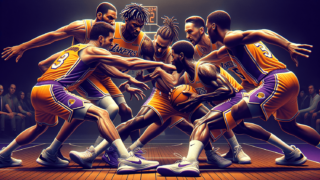
If you’re itching to get informed about one of the most critical aspects of basketball, you’ve come to the right place! The jump shot, an iconic move that has fueled countless game-winning moments and shaped the careers of legendary players, is an essential skill for anyone looking to up their basketball game. Combining finesse, precision, and split-second decision-making, a jump shot can make the difference between walking off the court as a hero or leaving with a sense of defeat. So buckle up and prepare for an exhilarating deep dive into the mechanics, history, and artistry of the jump shot in basketball.
What Is a Jump Shot in Basketball?
A jump shot in basketball is an offensive maneuver where a player jumps into the air and releases the ball with one or both hands towards the hoop, attempting to score points. It’s a fundamental shot type, primarily used when a player is being guarded by an opponent, as the jump provides added height and an unobstructed shooting angle. Mastering the jump shot is crucial for players to become versatile and effective scorers on the court.
Origins of the Jump Shot
The jump shot hasn’t always been a cornerstone of basketball. In the early days of the sport, players relied on low-set shots and two-handed push shots for scoring. The jump shot only emerged onto the scene during the late 1930s and early 1940s when pioneers like Bud Palmer, Kenny Sailors, and Joe Fulks started perfecting this potent technique. Over the following decades, as it proved to be an effective offensive weapon, the jump shot spread throughout the basketball community, firmly establishing itself as a fundamental skill in the sport’s lexicon.
Mechanics of a Perfect Jump Shot
To reach the highest level of proficiency in jump shooting, players must break down and understand its mechanics. Each component of the shot, from the positioning of the hands to the timing of the jump, is crucial in mastering the technique. Here, we’ll dissect the factors that contribute to a perfect jump shot:
1. The Stance and Setup
Like any great journey, a perfect jump shot begins with a solid foundation. In this case, that foundation is the player’s body position and setup. Players should adopt a balanced stance with their feet shoulder-width apart, knees slightly bent, and bodyweight centered. The non-shooting hand should be positioned to support the shooting hand, placed to the side of the ball.
2. The Shooting Hand
It’s all in the shooting hand! The placement of the shooting hand is central to jump shot accuracy. Players should place their dominant hand under the ball, ensuring that their fingers – and not their palm – make primary contact. The hand should be centered, lining up the ball with the middle of their body to give them the best chance to shoot straight.
3. The Shot Pocket
The term “shot pocket” refers to the spot where the ball rests before a player begins their shooting motion. For a jump shot, a good shot pocket is typically near the chest or under the chin, allowing the player to swiftly transition from dribbling to shooting. Maintaining control and keeping the ball steady while in this position provides a greater likelihood of a successful shot.
4. The Jump
The jump is the hallmark of the jump shot. It’s what separates an average shot from an unblockable weapon. Prior to jumping, the player should extend their legs and transfer their body’s energy up through their hips, back, and arms. The secret to a great jump is maintaining balance and elegance mid-air.
5. Release and Follow-Through
The moment of truth – the release. As the player reaches the peak of their jump, they’ll need to release the ball, relying on a perfect marriage of the aforementioned mechanics. The shooting hand extends forward, with a fluid flick of the wrist that sends the ball gracefully towards the hoop. A proper follow-through – an outward and upward motion of the shooting hand’s wrist and fingers – helps ensure accuracy and a good backspin on the ball.
Developing a Consistent Jump Shot
Once a player understands the mechanics of a jump shot, they’ll need to start practicing and building muscle memory. This process can be broken down into three main phases:
1. Form Shooting Drills
First, a player should focus on their shooting form without worrying about the jump. Form shooting drills allow players to refine their hand placement, release, and follow-through. These exercises should be practiced close to the hoop, gradually increasing distance as the player becomes more accurate.
2. Incorporating the Jump
With solid shooting form established, it’s time to factor in the jump. Practice one-motion shots, focusing on a smooth transition between setup, jump, and release. The key here is to ensure that the jump does not disrupt the shooting form, and players should work on maintaining their balance in the air.
3. Game-like Scenarios
The true test of a player’s jump shot is its effectiveness in a basketball game, where pressure, speed, and unpredictability come into play. Incorporate game-like scenarios that challenge the player to adapt their technique under said conditions. This practice will prepare a player to confidently execute their jump shot when it counts, making for a scalable, valuable skillset on any basketball court.
Jump Shot Variations
A well-rounded player will have a diverse offensive arsenal, which includes different variations and adaptations of the jump shot. Here are several to consider:
1. The Pull-up Jumper
This jump shot variation is performed off the dribble, requiring the player to fluidly transition from a fast drive to a balanced jump and release. It’s an excellent tool against defenders playing tightly, as it provides an opportunity to break free.
2. The Fadeaway
The fadeaway is a jump shot where the player leans back in mid-air, creating separation from the defender as they release the ball. This move is associated with the likes of Michael Jordan and Kobe Bryant, who used it to devastating effect throughout their careers.
3. The Step-Back Jumper
The step-back jumper entails the player dribbling in one direction before quickly creating space between them and the defender with a deft step-back move. At this point, they launch a jump shot. James Harden and Stephen Curry have both mastered this technique, making it a lethal scoring option in the modern game.
Jump Shooters in Basketball History
Let’s take a moment to celebrate the iconic players who have exhibited exceptional prowess in the realm of the jump shot. These athletes have left indelible marks on basketball history, inspiring generations to come:
1. The Classics: Bob Pettit and Jerry West
Bob Pettit and Jerry West are early jump shooting legends. With textbook form, game-changing ferocity, and uncanny consistency, these players blazed a trail for future stars to follow.
2. The Modern Standard: Larry Bird and Michael Jordan
Larry Bird and Michael Jordan captivated the world with their performances, especially their explosive midrange jump shots. Their finesse and unyielding dedication to their craft left a lasting impact on the game of basketball.
3. The Three-Point Era: Stephen Curry and Klay Thompson
Stephen Curry and Klay Thompson have brought the jump shot to new heights with their incredible range and seemingly effortless long-distance shooting. They represent the evolution of the jump shot and have left an indelible mark on the game, demonstrating just how far the evolution of the jump shot has come in basketball.
Drills to Improve Your Jump Shot
To hone the jump shot craft, consistent and focused practice is critical. Here are a few drills that can help players refine their skills and perform under pressure:
1. Around the World
The Around the World drill challenges players to make shots from various spots around the court. By practicing from diverse positions, a player can develop their shooting technique with a broad range of angles and distances, boosting their overall versatility.
2. Catch and Shoot
The Catch and Shoot drill allows players to work on receiving passes and shooting in a single fluid motion. Mimicking game situations where openings may be brief, the Catch and Shoot drill promotes rapid decision-making and smooth execution.
3. Beat the Pro
Beat the Pro is a mentally-focused drill, requiring players to make more shots than an imaginary counterpart. As a player records their successes and failures, they can set goals for improvement. This drill fosters mental resilience, focus, and a competitive spirit.
The Importance of the Jump Shot for Basketball Success
The jump shot has been a defining element in the landscape of basketball for nearly a century. A single technique that demands precision and grace, it remains a beautiful testament to human athleticism in its marriage of physics, timing, and sheer determination. In cultivating the art of the jump shot, players not only showcase their commitment to the game but also their ability to continually push boundaries, evolve, and contribute to the ongoing legacy of basketball as a thrilling, kinetic spectacle.
Defensive Strategies Against the Jump Shot
As important as it is to become a potent jump shooter, developing strategies to counteract the jump shot is vital for maintaining a strong defense. Here, we’ll delve into some popular defensive techniques aimed at neutralizing the offensive power of the jump shot:
1. Contesting the Shot
One of the simplest yet most effective ways to defend against a jump shot is to contest it. By raising a hand or approaching the shooter, defenders can block or disrupt the shooter’s line of sight to the hoop, making it more challenging for them to accurately aim and execute their shot.
2. Closing the Gap
By closing the gap between themselves and the shooter, defenders can apply pressure, making the shooter feel rushed or even deter them from attempting a jump shot altogether. However, defenders must be cautious not to over-commit, as this may leave them vulnerable to drives or pass plays by the offense.
3. Utilizing Help Defense
Help defense requires teammates to work together to cover for one another’s defensive assignments. When confronting a strong jump shooter, help defense can be instrumental in putting added pressure on the shooter, negating their offensive threat while maintaining overall defensive integrity.
Injury Prevention and Conditioning for Jump Shooters
Achieving jump shot mastery demands constant practice and repetition. To maintain peak performance and minimize injury risk, jump shooters should invest in proper conditioning and strengthening exercises. Here are a few critical areas to focus on to ensure longevity and safety on the court:
1. Lower Body Strength
Building strong and stable leg muscles is essential for executing consistent, powerful jump shots. Exercises like squats, lunges, and calf raises can help strengthen the lower body, providing a solid foundation for both jumping and landing.
2. Core Stability
Often overlooked, core strength is vital for maintaining balance and control during a jump shot. Engaging in exercises like planks, leg raises, and Russian twists can help build the necessary core stability for players to excel at their craft.
3. Flexibility and Mobility
Jump shooting places substantial strain on joints and muscles. Prioritizing flexibility and mobility can help prevent injuries and allow for a greater range of motion during execution. Regular stretching and dynamic warm-ups are key elements to maintaining a healthy range of motion and avoiding stiffness in muscles and joints.
Famous Jump Shot Moments in Basketball History
Throughout the years, there have been countless unforgettable jump shot moments that have shaped basketball history. Let’s reminisce on a few iconic jump shot moments that left fans stunned and created basketball folklore:
1. Michael Jordan’s “The Shot”
Game 5 of the 1989 NBA Eastern Conference First Round saw Michael Jordan hit one of the most famous jump shots in history. With a buzzer-beater over Craig Ehlo, Jordan secured the Chicago Bulls’ victory and created a moment that will never be forgotten.
2. Ray Allen’s Clutch Three-Pointer
In Game 6 of the 2013 NBA Finals, Ray Allen etched his name in history by sinking an iconic corner three-pointer for the Miami Heat to tie the game against the San Antonio Spurs. With just seconds left on the clock, Allen’s shot sent the game into overtime, ultimately leading the Heat to an NBA championship.
3. Kyrie Irving’s Dagger
During Game 7 of the 2016 NBA Finals, Kyrie Irving of the Cleveland Cavaliers hit a clutch go-ahead three-pointer over Stephen Curry with less than a minute remaining on the clock. Irving’s shot proved crucial in securing the Cavaliers’ first-ever NBA championship and solidifying his jump shooting legacy.
Jump Shot Trivia
To showcase your love and appreciation for the jump shot, here are a few fun trivia questions to challenge fellow fanatics and aspiring jump shooters alike:
- Who is credited with inventing the jump shot in the late 1930s?
- Which NBA player currently holds the record for most jump shots made in a single game? How many jump shots did they make?
- What is the maximum distance from the hoop a player can shoot a jump shot while still earning three points?
FAQ Section: Jump Shot 101
Jump shots are a staple of modern basketball – so it’s natural to have questions about mastering and defending against this powerful technique. In this FAQ section, we will address some of the most common questions related to the jump shot, ensuring you have plenty of ammunition (knowledge) for your next water cooler conversation or practice session.
1. Who invented the jump shot?
Bud Palmer, Kenny Sailors, and Joe Fulks are generally credited with independently developing the jump shot during the late 1930s and early 1940s. Their innovation transformed the game of basketball and paved the way for the jump shot to become a fundamental skill in the sport.
2. How important is the follow-through in a jump shot?
The follow-through is crucial for a successful jump shot, as it helps ensure accuracy and proper backspin on the ball. A good follow-through involves extending the shooting arm and flicking the wrist outward and upward, creating a smooth and fluid motion while releasing the ball.
3. What is a good shooting form for a jump shot?
An effective shooting form for jump shots requires a balanced stance, proper hand placement, accurate shot alignment, and a consistent release. Players should begin with a stable body position, hold the ball with the fingertips (not the palm), and maintain a straight alignment of the ball, elbow, and wrist throughout the shooting motion.
4. How can I improve my shooting range?
Improving your shooting range requires practice and a focus on strengthening your shooting form. By working on your lower body and core strength and regularly practicing jump shots from different distances, you can gradually enhance your ability to shoot consistently from longer ranges.
5. How can I practice my jump shot if I don’t have access to a court?
If you don’t have access to a court, there are still several ways to practice your jump shot. First, you can work on your shooting form without the ball, focusing on your hand and elbow placement, body position, and follow-through. Additionally, mental visualization exercises can help you stay sharp and refine your jump shot mechanics.
6. How do I defend against a jump shot?
To defend against a jump shot, consider contesting the shot by raising your hand or approaching the shooter, maintaining a tight gap and pressuring the shooter, and utilizing help defense in cooperation with your teammates. Effective defense requires a combination of awareness, agility, and technique.
7. What is the most famous jump shot in basketball history?
While several famous jump shots have shaped basketball history, Michael Jordan’s “The Shot” in Game 5 of the 1989 NBA Eastern Conference First Round is often considered the most iconic. With a buzzer-beating jump shot over Craig Ehlo, Jordan secured the Chicago Bulls’ victory and created a moment that is forever etched in basketball lore.
8. Can a jump shot earn three points?
Yes, a jump shot can earn three points if the shooter’s feet are outside the three-point arc when the ball is released. Three-pointers are an effective offensive weapon and can help stretch the defense by forcing them to guard a larger area of the court.
9. What is the difference between a jump shot and a set shot?
The main difference between a jump shot and a set shot is that a jump shooter leaps into the air to release the ball, while a set shooter remains on the ground. Jump shots provide the added benefit of increased height and a more challenging shot for defenders to block.
10. What is a good percentage for a jump shooter?
A good jump shooting percentage varies depending on factors like shot distance, shot difficulty, and overall player skill level. Generally, a shooting percentage above 45% for two-point jump shots and 40% for three-pointers is considered effective for professional and high-level players.
11. Why is the jump shot so important in basketball?
The jump shot is essential in basketball because it allows a player to shoot over defenders, making it more difficult to block. Additionally, a precise and consistent jump shot can open up the floor for a basketball team, forcing defenders to spread out and respect the shooter’s range.
12. How long does it take to master a jump shot?
Mastering a jump shot varies depending on individual skill levels, practice habits, and physical attributes. Consistent, focused practice and a commitment to strengthening the key aspects of
Featured Posts
- No pillar pages found.





